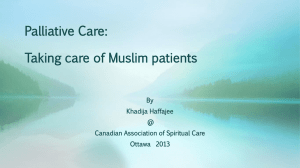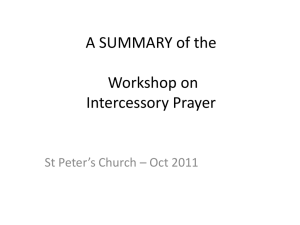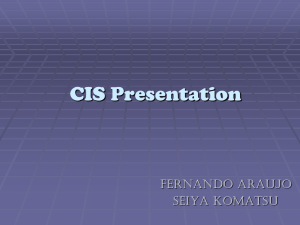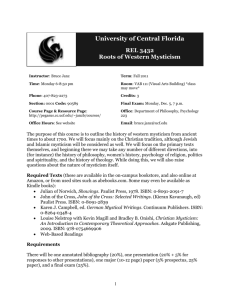OC_Lecturenotes_Pchology_William_James
advertisement
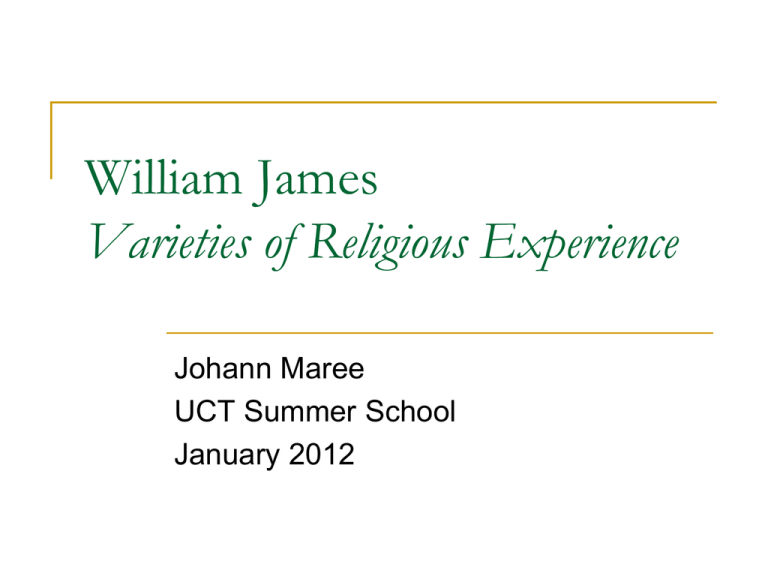
William James Varieties of Religious Experience Johann Maree UCT Summer School January 2012 William James: a very brief biography William James (1842 – 1910) was a pioneering American psychologist and philosopher who was trained as a physician. He was the brother of the novelist Henry James and son of a wealthy and notoriously eccentric theologian who was well acquainted with the literary and intellectual elites of the day. James’ Approach in Varieties of Religion James emphasized that his enquiry into religion was ‘not (of) religious institutions, but rather religious feelings and religious impulses’. (p.26) He explains: ‘It would profit us little to study … second-hand religious life. We must make search rather for the original experiences which were the pattern setters to all this mass of suggested feeling and imitated conduct. These experiences we can only find in individuals for whom religions exists not as a dull habit, but as an acute fever rather. But such individuals are “geniuses” in the religious line.’ (p.29) Religious “genuises” These “geniuses”, are ‘superhuman’ people like, Christ, the Buddha, Mohammed, who became the founders of new religious traditions and ‘owed their power originally to the fact of their direct personal communion with the divine.’ James’ starting point James’s starting point is to sketch two extreme types of humans, the ‘healthy-minded’ and the ‘sick soul’. The healthy-minded person is one ‘whose soul is of this sky-blue tint, whose affinities are rather with flowers and birds and all enchanting innocencies than with dark human passions, who can think no ill of man or God…’ (p.94) James refers to them as the once-born in contrast to the twice-born who belong to the category of the ‘sick soul’. (p.94) The ‘sick soul’ James becomes heavy when he deals with the sick soul. Here is what one of them who was a patient in a French asylum suffered: ‘I no longer sleep since I am shut up here, and the little rest I get is broken by bad dreams, and I am waked with a jump by nightmares, dreadful visions, lightning, thunder … Fear, atrocious fear, presses me down, holds me without respite, never lets me go. … But God knows neither middle way nor limits. I say God, but why? All I have known so far has been the devil. After all, I am afraid of God as much as of the devil, so I drift along, thinking of nothing but suicide, but with neither courage nor means here to execute the act.’ (pp.155-56) The divided self and unification James describes the sick soul as a person with a divided self and that the way out of the dilemma is through a process of unification. ‘The process of unification, when it occurs, may come gradually, or it may occur abruptly; it may come through altered feelings, or through altered powers of action; or it may come through new intellectual insights, or through experiences which we shall later have to designate as “mystical”. However it come, it brings a characteristic sort of relief; and never such extreme relief as when it is cast into the religious mould. Happiness!’ (p.180) Conversion: the ‘hot place’ When the unification process is religious in nature James refers to it as conversion. Two aspects stand out with regards to conversion: the ‘hot place’ (no, not hell!) and self-surrender. The ‘hot place’ refers to emotional excitement created in a person’s consciousness. It changes a person’s orientation and what she or he most wants to do. James regards hot places as centres of dynamic energy. Conversion then means that religious ideas, previously peripheral in a person’s consciousness, ‘take a central place, and that religious aims form the habitual centre of his energy’. (p.201) Self-surrender The second aspect of conversion is selfsurrender. Drawing on Starbuck, James says self-surrender is indispensable for conversion. ‘The personal will must be given up. In many cases relief persistently refuses to come until the person ceases to resist, or (ceases) to make an effort in the direction he desires to go.’ (Starbuck quoted by James, p.211) Fruits of conversion James sees the fruits of conversion being a spiritual tree with two main branches The first is a conviction of the existence of an ‘Ideal Power’ that is perceived as God by Jews, Christians and Muslims. (p.269) Combined with this is a ‘friendly continuity’ with the Ideal Power and ‘a willing surrender to its control’ Conviction of a Presence ‘It will be found that men of preeminent saintliness agree very closely in what they tell us. They tell us that they have arrived at an unshakeable conviction, not based on inference but on immediate experience, that God is a spirit with whom the human spirit can hold intercourse; that in him meet all that they can imagine of goodness, truth, and beauty; they can see his footprints everywhere in nature, and feel his presence within them as the very life of their life, so that in proportion as they come to themselves they come to him.’ (p.269 fn 2.) Second main branch: love The second main branch of the spiritual tree constitutes ‘a shifting of the emotional centre towards loving and harmonious affections’ that have ‘characteristic practical consequences’. (p.270) They are, according to James, devoutness, asceticism, a strengthening of the soul, attaining ‘new reaches of patience and fortitude’, purity and charity. Value of the fruits of conversion James subjects the fruits of conversion to empirical evaluation and comes to the conclusion that they are not always beneficial. Sometimes they can be highly destructive. With regards to devoutness James points out that, when carried to an extreme, it can give rise to fanaticism. One particularly dangerous turn this fanaticism can take is ‘jealousy for the deity’s honour’. In ‘exceedingly narrow minds’ this can become obsessively dangerous. Dangers of fanatical devotion ‘crusades have been preached and massacres instigated for no other reason than to remove a fancied insult upon the God. … It is a partisan temper, and that is cruel. … A Catherine of Siena, panting to stop the warfare among Christians which was the scandal of her epoch, can think of no better method of union among them than a crusade to massacre the Turks.’ (p.334) Tenderness and charity But excesses of tenderness and charity make the world a much better place. ‘were there no one prompt to help a brother first, and find out afterwards whether he were worthy; … no one glad to treat individuals passionately and impulsively rather than by general rules of prudence; the world would be an infinitely worse place than it is now to live in.’ (p.347) Truthfulness of religion: Mysticism James realizes that it is strange to consider the value of religion by its utility as he did by considering the fruits of conversion. Instead, he decides to weigh up religion by its truthfulness. He does so by examining one special manner in which truth is manifested in religion, namely mysticism. James regarded the complete unification between a person and God as the great achievement of mysticism. Mysticism opens new doors Mystical states open the door to alternative forms of knowledge. James says ‘It resembles the knowledge given to us by sensations more than given by conceptual thought.’ (p.391) This paves the way to the existence of other forms of consciousness: ‘they break down the authority of the non-mystical or rationalistic consciousness, based upon the understanding and the senses alone. They show it to be only one kind of consciousness. They open out the possibility of other orders of truth…’ (p.407) The Incommunicableness of mystical experiences Mystical experiences cannot be explained in words. They remain an intensely private experience. Hence the ‘incommunicableness of the transport is the keynote of all mysticism’ (p.391) As a result there is very little transference of the revelations of mystical states to a wider community of believers. ‘Systematic theology’ and God Next James considers what metaphysical philosophy, that he also refers to as ‘systematic theology’, has to say about the attributes of God. Metaphysics seeks to uncover what is ultimately real. The attributes make up a long list: God is First Cause, necessary, absolute, one, spiritual, simple and non-physical, immutable, immense, boundless, intelligent, self-sufficient, omniscient, omnipotent, can make being, creates ex nihilo, is holy, good and just. (pp.422-424) James’ attack on ‘systematic theology’ James considers these metaphysical attributes to be ‘absolutely worthless inventions and launches a scathing attack on ‘systematic theology’. The attributes of God merely constitute ‘a shuffling and matching of pedantic dictionary-adjectives, aloof from morals, aloof from human needs… They are only a set of titles obtained by a mechanical manipulation of synonyms; verbality has stepped into the place of vision, professionalism into that of life. Instead of bread we have a stone; instead of a fish, a serpent… (p.428) Prayer the answer to religion James reveals that prayer is how humans tap into religion. It is the lifeblood of religion. If there is no prayer involved in a system of belief then it is not a religion. Once again James says it in his own inimitable way. Prayer the essence of religion ‘Prayer … is the very soul and essence of religion. “Religion,” says a liberal French theologian, “is an intercourse, a conscious and voluntary relation, entered into by a soul in distress with the mysterious power upon which it feels itself to depend, and upon which its fate is contingent. This intercourse with God is realized by prayer. Prayer is religion in act; that is, prayer is real religion. … Wherever this interior prayer is lacking, there is no religion; where, on the other hand, this prayer rises and stirs the soul, even in the absence of forms or of doctrines, we have living religion.”’ (p.444) Prayer releases energy He proceeds to make a most serious claim about religion and prayer by stating that religion insists that by means of prayer alone energy is released which brings about real change in the world which we live. Through prayer, James insists, things which cannot be realized in any other manner come about: energy which but for prayers would be bound is by prayer set free and operates in some part, be it objective or subjective, on the world of facts.’ (pp.445-46) Varieties’ conclusion James makes two important points when summing up the broad characteristics of religious life. They are firstly, ‘that the visible world is part of a more spiritual universe from which it draws its chief significance’, and, secondly, that prayer or ‘inner communion’ with God is ‘a process wherein work is really done, and spiritual energy flows in and produces effects, psychological or material, with the phenomenal world.’ (p.464) Criticisms of Varieties There are three main criticisms that can be made of Varieties of Religious Experience. First, it is too limiting of James to focus on religion as only based on experiences that create feelings or emotions of one kind or another in the believer. While it is understandable why he does so as a psychologist, he omits important aspects of religion by excluding believers who have not experienced religious emotions or feelings even though they are sincere believers and upholders of their faith. Bifurcation Second, the bifurcation of human personality into only two types, the healthy-minded and the sick soul, is incomplete. These two types represent opposite ends of a continuum of personality types that lie from one end of the spectrum to the other. There are people who are optimistic and cheerful by nature, but who acknowledge the existence of wrongdoing and can get downcast or even depressed. Conversely, there are people who do suffer from depression or guilt or a sense of failure, but it is not their normal or permanent state. Attack on ‘systematic theology’ Third, James’s vicious attack on ‘systematic theology’ is not well grounded. By so doing he rejects the insights of systematic theologians and is in danger of throwing out the baby with the bathwater. However, much theological writing may be dry as dust in some cases, it can provide the believer with a reasoned and insightful overview of the whole framework of belief of the believer’s religion. There are many theologians who have broken new ground in helping believers understand and practice their faith better and more sincerely. Varieties and personal wholeness Although James did not set out to address the question of personal wholeness in his book, it in fact contains a very good exposition how the ‘sick soul’ is made whole. It happens through religious conversion which completely re-orientates the person towards a new life. The ‘hot place’ as a centre of dynamic energy The ‘hot place’ is a centre of dynamic energy and changes a person’s orientation to what she or he most wants to do. Conversion then means that religious ideas, previously peripheral in a person’s consciousness, ‘take a central place, and that religious aims form the habitual centre of his energy’. Appreciation of Varieties In addition to dealing with healing to attain wholeness from a religious perspective, there are other valuable insights by James. These are: The central role of prayer in religion The perception of two universes, the one ours, the other spiritual, and that energy flows from the spiritual to our universe by means of prayer.



